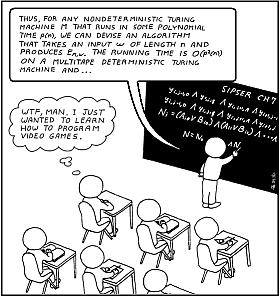David Stanovský
// 
|

|
| ALGEBRAIC INVARIANTS IN KNOT THEORY 2025/26 |
Syllabus:
- Fundamental concepts of knot theory: equivalence, Reidemeister moves, basic invariants
- Coloring invariants
- Seifert surfaces, Alexander polynomial
- Skein relations, Conway and Jones polynomial
- Braid groups
- Vassiliev invariants
The principal material is the book Knot Theory and Its Applications by Kunio Murasugi. The lecture mostly follows the book, up to a couple of reorderings and proof corrections :-)
As a supplementary material, covid videos from 2021 are available at the older website of the course. This year, we will cover similar, but not exactly the same topics, and the exposition will be much better.
Program: (actual for past lectures, tentative for future lectures):
| lecturer | topic | Murasugi | other materials | exercises | |
| 30.9. | DS | Introduction: a computational view of knot theory. Fundamental concepts: knots and links, equivalence, diagrams . |
--- 1.1-1.4, 2.1 |
intro slides pěkné motivační video |
Gauss codes [M 2.2] |
| 7.10. | RO | Arithmetic of knots: connected sum, inverses, mirror images. Some naive invariants. |
1.5 4.2-4.4 |
Knot decompositions | |
| 14.10. | JŠ | Reidemester theorem. Invariants: linking number, writhe. | 4.1, 4.5 | Reidemeister moves and linking number | |
| 21.10. | DS | Coloring invariants. | 4.6 | more on quandle coloring | Knot coloring |
| 28.10. | -- | *** státní svátek *** | -- | ||
| 4.11. | DS | Conway polynomial (via skein relation). | 6.2 | proof of existence | Conway polynomial |
| 11.11. | RO | Seifert surfaces and their genus, Seifert matrices. | 5.1-5.3 | Seifert surfaces | |
| 18.11. | JŠ/RO? | Equivalence of Seifert matrices. | 5.4, 6.1 | Alexander polynomial | |
| 25.11. | JŠ? | Properties of the Alexander polynomial, its relation to the Conway polynomial. | 6.1-6.3 / 6.4 (pract.) | More invariants, distinguishing mirror images | |
| 2.12. | JŠ? | Kauffmann bracket, Jones polynomial: definition, calculation. | 11.4, 11.1 | Jones polynomial | |
| 9.12. | JŠ? | Jones polynomial: properties, generalizations. | 11.2, 11.3 | ||
| 16.12. | DS? | Vassiliev invariants. | 15 | Torus knots | |
| 6.1. | DS? | Vassiliev invariants. | 15 |
Torus knots |
Other literature:
- any book on knot theory, a particularly good one is, for instance, P. Cromwell: Knots and Links, or C. Adams: The Knot Book, or W. B. R. Lickorish: An intro to Knot Theory
- knot coloring - Nelson, Elhamdadi: Quandles: An Introduction to the Algebra of Knots
